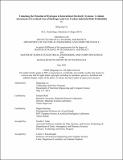Unlocking the Potential of Hydrogen in Intermittent Electricity Systems: A Global Assessment of Levelized Cost of Hydrogen and Low Carbon Industrial Hub Profitability
Author(s)
Liu, Qingyang
DownloadThesis PDF (6.964Mb)
Advisor
Roth, Richard
Barzilay, Regina
Terms of use
Metadata
Show full item recordAbstract
Recently, numerous countries have announced ambitious hydrogen production targets among clean energy transition objectives, recognizing the potential of hydrogen in decarbonization. However, significant uncertainty remains regarding the cost predictions for hydrogen production and the economic viability of green hydrogen-enabled industrial hubs with higher levels of intermittent renewable energy penetration. This study focuses on assessing the levelized cost of hydrogen generated through polymer electrolyte membrane electrolysis, accounting for regional variations, technology learning, energy intermittency and policy incentives such as those provided by the Inflation Reduction Act. We also evaluate the profitability and market viability of utilizing co-located hydrogen to decarbonize Aluminum and steel production in renewable-powered industrial hubs across various suitable regions worldwide. To accomplish this, we develop a generalizable cost model that identifies the optimal hydrogen production capacity factor and levelized cost of hydrogen under different levels of grid electricity volatility, and construct a regional hour-by-hour prioritized dispatch model to simulate a low-carbon industrial hub primarily powered by wind and solar supported by storage and firming. The results demonstrate that with the regions considered, the levelized cost of hydrogen is consistently high till 2040, but can be reduced to meet the $2/kg production cost target in the coming years through operating capacity optimization and the implementation of policy incentives. Besides, the optimal capacity leading to the lowest levelized cost of hydrogen is negatively correlated with electricity price volatility, highlighting hydrogen’s potential as a cost-effective means to absorb fluctuations in grid electricity prices. Moreover, our analysis reveals that for industrial hubs, hydrogen is the most economically viable when integrated with an industry where hydrogen serves both as a material input and as a storage mechanism, as exemplified by green steel manufacturing with the hydrogen-based direct reduced iron-electric arc furnace process. Finally, an analysis on past policies, geopolitical interests, and resource exploitation in developing countries associated with hydrogen highlights additional political and social considerations in hydrogen policymaking from a global development perspective.
Date issued
2023-06Department
Massachusetts Institute of Technology. Department of Electrical Engineering and Computer Science; Massachusetts Institute of Technology. Institute for Data, Systems, and SocietyPublisher
Massachusetts Institute of Technology